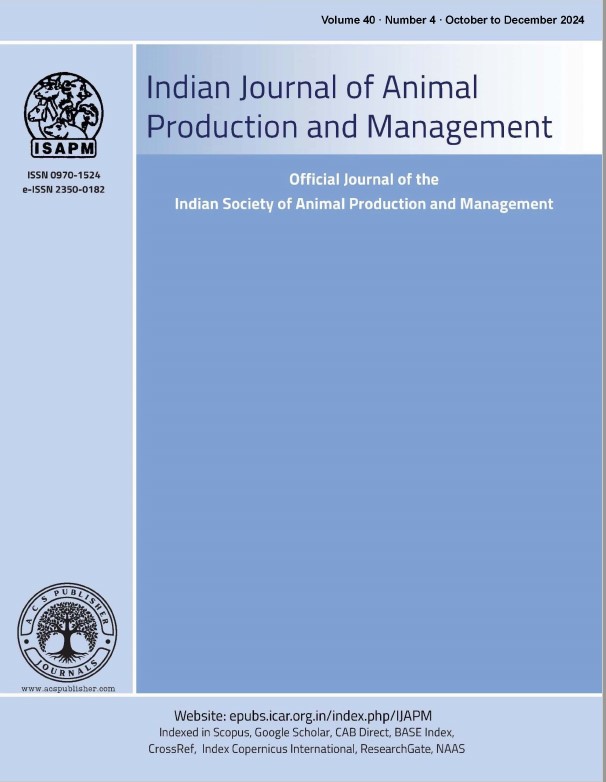Inclusion of Linseed (Linum usitatissimum) Meal on the Performance of Vanaraja Birds
DOI:
https://doi.org/10.48165/ijapm.2024.40.3.12Keywords:
Vanaraja birds, egg quality, blood biochemical parameters, egg productionAbstract
The present study was carried out with the objective of studying the reproductive performance, blood constituents and economics of rearing Vanaraja birds as influenced by the dietary inclusion of linseed meal. The study was conducted at the poultry unit of the department. A total of 120 female Vanaraja chicks were reared for a period of nine months and were randomly divided into four treatment groups (T1, T2, T3, and T4) of 30 birds, each having five replications per treatment following a randomized block design. They were subjected to four dietary levels of linseed meal, containing 0%, 4%, 8%, and 12%, respectively. The birds were reared under a deep litter system up to 8 weeks of age and thereafter in cages following standard management practices. Initial body weight was recorded at 1 day old, and thereafter it was recorded fortnightly. Feed intake and egg production were recorded daily. The control group had higher egg production, clutch size, and egg weight. Higher yolk weight, albumen weight, and yolk cholesterol were recorded in T3, while group T4 had the maximum HU. The lowest cholesterol and triglycerides were recorded in T4, while the highest HDL and lowest LDL were observed in the control group. The cost of production was highest in T4 and lowest in T2, while higher net profit per bird and net profit per gain were recorded in T3 as compared to the control group.
References
Adangale, S.B. 2018. Effect of linseed feeding on growth and meat quality of broilers and eggs quality in white leghorn layers. Ph.D. Thesis. Mahatma Phule Krishi Vidaypeeth, Rahuri.
Ahmad, S., Ahsan-ul-Haq, Yousaf, M., Sabri, M.A. and Kamran, Z. 2012. Response of laying hens to omega-3 fatty acids for performance and egg quality. Avian Biology Research. 5: 1-10.
Ahmad, S., Ahsan-ul-Haq., Yousaf, M., Kamran, Z., Ata-ur-Rehman, Sohail, M.U. and Sahid-ur Rahman. 2013. Effect of feeding whole linseed as a source of polysaturated fatty acids on performance and characteristics of laying hens kept at high ambient temperature. Brazilian Journal of Poultry Science. 15 (1): 21-26.
Bird, H. R. 1995. Performance Index of growing chickens. Poultry Science. 34 (5) : 1163-1164.
Duarte, K.F., Junqueira, O.M., Borges, L.L.,
Rodrigues, E., Filarde, R.D.S., Praes, M.F.F.M., de Laurentiz, A.C. and Domingues, C.D.F. 2014. Performances, carcass traits, and body composition of broilers fed different linseed oil levels between 21 and 56 days of age. Revista Brasileira de Ciencia Avicola. 16 (1): 55-60.
Haug, A., Greatorex, E. S., Bernhoft, A., Wold, J., Hetland, H., Christophersen, O.A. and Sogn, T. 2007. Effect of dietary selenium and omega-3 fatty acids on muscle composition and quality in broilers. Lipids in Health and Disease. 6: 29-
Haugh, R. R. 1937. The Haugh unit for measuring egg quality. United States Egg Poultry
Kajla, P., Sharma, A. and Sood, D.R. 2015. Flaxseed—a potential functional food source. Journal of Food Science and Technology. 52 (4): 1857–1871.
Kakade, D.N. 2015. Evaluation of cottonseed cake detoxified by solid state fermentation. Maharashtra Animal & Fishery Sciences University Nagpur. Accessed on 24 June 2023
Kumari, P., Chandramoni, Kumar, K. and Kumar, S. 2014. Effect of dietary supplement of sugar beet, neem leaf, linseed and coriander on growth performance and carcass trait of vanaraja chicken. Veterinary World. 7(9): 639-
Mangesh, B. P. 2017. Effect of feeding linseed powder on the growth of Giriraja. M.sc Thesis. DBSKKV. Dapoli. https://krishikosh.egranth.ac.in/items/1c9b3c8
-b5b7-4eb6-94f7-2feff92b7b8a.
Masek, T., Severin, K., Gottstein, Z., Filipovic, N., Stojevic, Z. and Mikulee, Z. 2013. Effects of early castration on production performance, serum lipids, fatty acid profile and desturation indexes in male chicken broilers fed a diet with increased fat content. Veterinarski archive. 83 (1): 233-243.
Mazalli, M.R., Faria, D.E., Salvador, D. and Ito, D.T. 2004. A comparison of the feeding value of different sources of fats for laying hens. Performance characteristics. Journal of Applied Poultry Research. 13 (2): 274-279.
Mohammad, Dh, S., Abdulrazad, S, H., Abulrahman, N, J. and Sardary, Y, S. 2019. Effect of adding grinded flax seed to the diet on productive performances and some
hematological traits in different lines of local quails. Tikrit Journal for Agricultural Sciences. 19 (3): 18-28.
Mridula, D., Kaur, D., Nagra, S.S., Barnwal, P., Gurumayum, S. and Singh, K.K. 2012. Effect of dietary flaxseed supplementation on egg production and quality in laying hens. Indian Journal Poultry Science. 47: 40-47.
Mridula, D., Kaur, D., Nagra, S.S., Barnwal, P., Gurumayum, S. and Singh, K.K. 2015. Growth performance and quality characteristics of flaxseed-fed broiler chicks. Journal of Animal Research. 43(3): 345-351.
Pisal, N. R. 2019. Studies on supplementation of linseed (Linum usitatissimum) oil in the feed of Giriraja poultry birds. M.sc Thesis, Department of Animal Husbandry and Dairy Science. Maharashtra.
Sahoo, A. and Jena, B. 2014. Designer egg and meat through nutrient manipulation. Journal of Poultry Science and Technology. 2 (3): 38-47.
Snedecor, G. W. and Cochran, W. G. 1998. Statistical Methods. 6th Edition Oxford and IBH Publishing Company, Kolkata, India.
Soni, R.P., Katoch, M., Kumar, A. and Verma, P. 2016. Flaxseed-composition and its health benefits. Research in Environment and Life Sciences. 9 (3) 310-316.
Tamasgen, N., Urge,M., Girma, M. and Nurfeta, A. 2021. Effect of dietary replacement of soybean meal with linseed meal on feed intake, growth performance and carcass quality of broilers. Heliyon. 7 (11): e08297.
Wang, L. and Huo, G. 2010. The Effects of Dietary Fatty Acid Pattern on Layer’s Performance and Egg Quality. Agricultural Sciences in China. 9 (2): 280-285.
Washburn, K. W. and Nix, D. F. 1973. A rapid technique for extraction of yolk cholesterol. Poultry Science. 53 (3): 1118-1122.
Yassein, S.A., El-Mallah, G.M., Ahmed, S.M., El Ghamry, A.A., Abdel-Fattah, M.M. and El Hariry, D.M. 2015. Response of laying hens to dietary flaxseed levels on performance, egg quality criteria, fatty acid composition of egg and some blood parameters. International Journal of Research Studies in Bioscience. 3 (10): 27-34.

